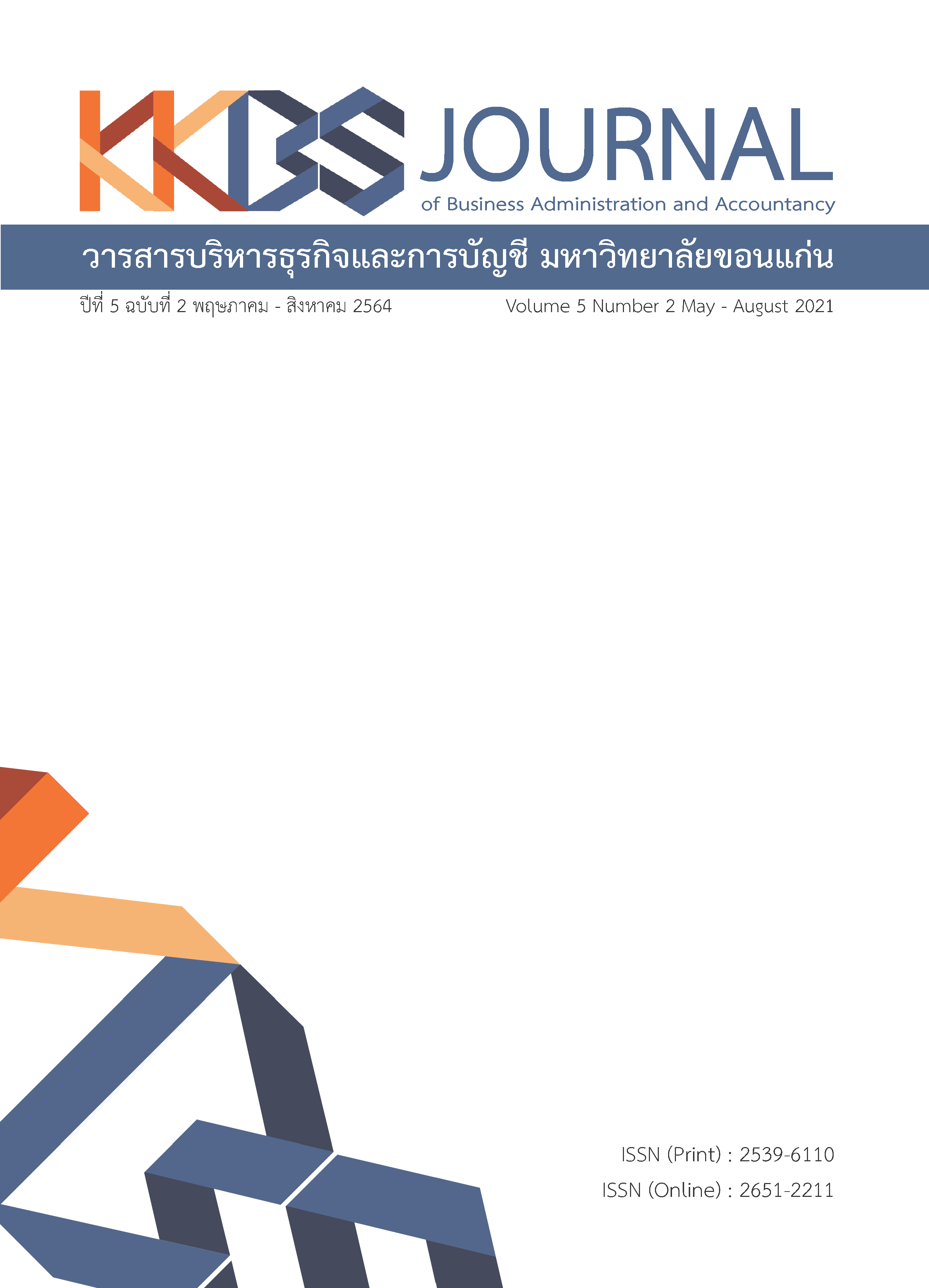Business Model and Profitability of Commercial Banking in Thailand
Main Article Content
Abstract
The purpose of this research is to study the banking business model inside of funding, income, and profitability of commercial banks in Thailand 2 groups, which are commercial banks registered in Thailand and foreign commercial bank branches. This study using quarterly time-series data from the 3rd quarter of the year 1999 to the first quarter of 2020, a total of 83 sets, and analyzed the data using multiple linear regressions by Ordinary least squares method. results found commercial banks registered in the country have a traditional business model that mainly have funds deposits and having income from loans Unlike foreign bank commercial branches have a non-traditional banking business that provides financing another, and find income from investments and other financial services as for the profitability of the commercial banks, it is found that both groups of commercial banks have level low profitability. In addition, it was found that financing by borrowing and issuing debt instruments has reduced the bank's profitability. But finding income from investment in securities affects the ability to make a profit in the same direction.
Article Details
The articles published in the journals are the authors' opinions, not the opinion of the editorial team or administrative staff. The articles published is copyright of the Journal of Business Administration and Accounting, Khon Kaen University.
References
Abreu, M. & Mendes, V. (2002). Commercial bank interest margins and profitability: evidence from E.U. countries. Porto: Working paper series.
Ahamed, M.M. (2017). Asset quality, non-interest income, and bank profitability: Evidence from Indian banks. Economic Modelling, 63, 1-14.
Ananchotikul, N. (2016). Credit banking and monetary policy transmission. Retrieved January 18, 2020, from https://www.pier.or.th/ (In Thai)
Ananchotikul, N. & Limjaroenrat, V. (2018). Insights Thai credit…How important is it for investment? Retrieved November, 18, 2019, from https://thaipublica.org/2018/01/pier-33/ (In Thai)
Ananchotikul, N. & Ratanavararak, L. (2018). The risk of Thai bank in the period of low interest rate. Retrieved November, 18, 2019, from http://www.pier.or.th. (In Thai)
Bank of Thailand. (2020a). Financial institutions and list names of financial institutions. Retrieved April, 29, 2020 from https://www.bot.or.th. (In Thai)
Bank of Thailand. (2020b). Financial institutions statistics table. Retrieved November, 25, 2020 from https://www.bot.or.th. (In Thai)
Bongini, P. et al. (2019). Profitability shocks and recovery in time of crisis evidence from European banks. Finance Research Letters, 30, 233-239.
Chantaphong, S. & Phongpiyapaiboon, N. (2017). 20 years of economic crisis: From lessons to the challenges ahead. Focused and Quick (FAQ), 115, 1-14. (In Thai)
Dechanube, P. (2016). Credit analysis and business credit trend. RMUTI Journal Humanities and Social Sciences, 10(1), 34-46. (In Thai)
Deekhao, W. (2016). Consumers’ behavior and marketing mix factors affecting application on the housing loan service of Government Savings Bank in Zone one of Chonburi Province. Sripatum Chonburi Journal, 12(3), 45-54. (In Thai)
Djalilov, K. & Piesse, J. (2016). Determinants of bank profitability in transition countries: What matters most? Research in International Business and Finance, 38, 69-82.
Hryckiewicz, A. & Kozlowski, L. (2017). Banking business models and the nature of financial crisis. Journal of International Money and Finance 71, 1–24.
Joaquin, M. (2017). Income structure, profitability and risk in the European banking sector: The impact of the crisis. Research in International Business and Finance, 39(Part A), 85-101.
Kaewjumpa, P., Jarernnsiripornkul, S. & Rittirod, T. (2016). A study of guidelines for increasing Bualuang Home Loan of Dokbua Bank Public Company Limited, Assadang road branch, Nakhon Ratchasima province. MBA-KKU Journal, 9(2), 217-238. (In Thai)
Kohler, M. (2014). Does non-interest income make banks more risky? Retail versus investment oriented banks. Review of Financial Economics, 23(4), 182-193.
Lerk-Somboondee, S. & Tanawitchabool, N. (2017). Net interest margin of Thai Commercial bank. Focused and Quick (FAQ), 118, 1-11. (In Thai)
Mensah, M.O. et al. (2017). Sovereign credit ratings and bank funding cost: Evidence from Africa. Research in International Business and Finance, 42, 887-899.
Nathaphan, S. & Kunapatarawong, R. (2016). Analysis of branch network of Thai Comercial banks. Suthiparithat Journal, 30(94), 128-142. (In Thai)
Pattarabanjird, S. (2016). Financial liquidity management for SMEs entrepreneur’s in world economic crisis. MBA-KKU Journal, 9(1), 281-303. (In Thai)
Roengpitya, R., Tatashev, N. & Tsatsaronis, K. (2014). Bank business models. BIS Quarterly Review, (December), 55-65.
Rym Ayadi. (2016). Bank business models in Europe: why does it matter for the future of regulation and resolution? Retrieved November, 25, 2020 from https://rymayadi.com/why-do-bank-business-models-in-europe-matter-for-the-future-of-regulation-and-resolution/
Singhon, K. (2016). Development of universal banking and legal mechanisms in financial consumer protection: a lesson on financial consumer protection failure during us subprime financial crisis 2008. NIDA Development Journal, 56(3), 68-107. (In Thai)
Sophaphon, P. (2015). Guidelines for the development of service quality in the service counter, Krung Thai Bank, Kuchinarai Branch, Kalasin Province. MBA-KKU Journal, 8(1), 152-170. (In Thai)
Thiangtong, V., Visavakosol, K. & Chancharat, N. (2018). Factors Influencing the profitability of The Thai Commercial Banks. Research Journal Phranakhon Rajabhat: Humanities and Social Science, 13(1), 295-310. (In Thai)
Thanomwong, P. (2019). Satisfaction in service selection and quality of service influenced the development of the deposit business of the Government Savings Bank in Bangkok (Region 3). Journal of Business Administration and Social Sciences Ramkhamhaeng University, 2(1), 76-91. (In Thai)
Trairatvorakul, P. & Watcharachaisurapon, T. (2006). New business model of commercial banks. Bangkok: TDRI. (In Thai)
Vo, X.V. (2018). Bank lending behavior in emerging markets. Finance Research Letters, 27(C), 129-134.
Yakean, S. & Homboonma, P. (2016). Factors Influencing the adoption of Government Savings Bank’s financial services in urban and rural Areas in Lampang Province. Journal of Business, Economics and Communications, 11(2), 160-171. (In Thai)


